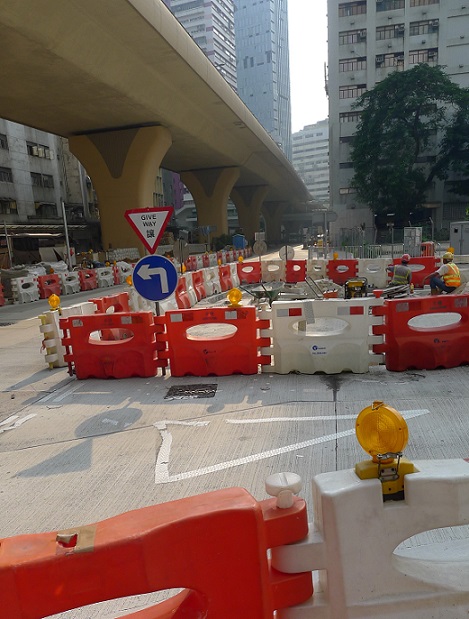藝評
擬建藝發局辦公室再顯從上而下的決策 (Top-down Decision-Making for New Arts Office)
約翰百德 (John BATTEN)
at 3:20pm on 19th April 2016

圖片說明 Caption:
黃竹坑道和高架道路,右方為前香港仔消防處用地。Site of proposed HKADC offices (right) in Wong Chuk Hang. Photo: John Batten.
(Please scroll down for English version.)
2015年11月中,立法會民政事務委員會的議程上出現了一項未經公佈的討論項目。議題所討論的是一項價值3.5億港元的發展提案,在前香港仔消防局用地興建一個設有28個藝術家工作室和一個藝術展覽廳的藝術空間和香港藝術發展局永久辦事處。這塊政府用地將會出售,而成功贏得發展權的發展商將需根據土地租用及銷售條件提供這些藝術設施,在新落成商廈中租回香港藝術發展局。
這項建議令人想到另一項近期引起爭議的民政事務局宣佈事項:在上環文武廟建築群內的空置校舍,興建一座樓高21層的青年宿舍。這項發展位於法定古跡旁,顯然並不恰當。事件引起了前古物古蹟辦事處主席及現任行政會議成員陳智思先生的關注,他最近便在報章上發表評論文章,表示為確保文武廟得到妥善的保護,發展必須作出妥協,青年宿舍應考慮在另一工地興建。
民政事務局的香港藝術發展局建議,似乎有著類似的從上而下決策問題,實應需要更廣泛的公共討論。作個獨立運作的法定組織,這些安排會不會影響或限制藝發局的獨立性或發揮角色作用的能力?這樣做真的可以讓該局方在財務與地點上更加穩定?藝發局的新藝術展覽廳和藝術家工作室,是不是真的應設於相對上較遙遠的黃竹坑,與一些商業畫廊為鄰?任何商人都明白租用物業可以提供較大的彈性,方便擴大和縮小規模,也可以遷往不同地方,而且毋需綁死資金。藝發局此前便曾被審計署批評,指其租用的辦公室空間遠多於實際所需,這項資料應該連同為藝發局提供永久辦事處的好壞,以及有關藝術展覽廳和藝術家工作室的需要分析,附加於提交予民政事務委員會的討論文件中。
藝發局是一家法定的藝術機構,其中一項主要職能是批核項目經費。它本身並非富有經驗的藝術設施營運者 ,所長也不在於親自管理藝術節目編排。藝發局應繼續把這些工作外判。藝發局現時管理油麻地上海街藝術空間的行政工作,但該空間的營運及節目編排一直都由社區及藝術組織負責。香港需要較少而非更多的政府運作展覽空間。大部份藝術場館和展覽空間現時都由康樂及文化事務署營運,轄下展場有不少使用限制,少有彈性安排,也不容許設施可以被弄髒的「骯髒」藝術展覽;大部份政府空間都只用作以掛圖形式展出清潔、不具爭議的藝術品。
香港的藝術家一般都選擇在火炭、葵涌、觀塘和新蒲崗等地區的私人工廈內設立工作室。這些地點所以大受歡迎,是因為它們鄰近藝術家居於新界的家人。除了藝發局將營運至2020年的新設創協坊工作室外,黃竹坑沒有多少藝術家工作室。黃竹坑區內適合藝術家使用的小型獨立工業單位更是寥寥無幾。自約10年前,黃竹坑由本來的工業區被重新規劃成「商業/辦公室」區,租金相宜的工廈也買少見少。現時很多工廈經已拆除,取而代之的是可以較高價格出租的酒店和商業大廈。
黃竹坑現時確有不少商業畫廊,大都在過去4年內開業,但這些畫廊都位於工業大廈內。以舊工廈為家的畫廊,技術上而言是不合法的,因為作為提供「公共娛樂」的畫廊,它們必須竹符合嚴謹的防火、樓梯及出口要求。港鐵南港島線在本年稍後通車,將進一步加快黃竹坑從工業區演化成商業地區的步伐。隨著區內舊工廈一一清拆,畫廊不一定會直接搬往租金較高的同區商廈。現時黃竹坑的吸引之處,在於其位處前身為工廈的地方,成本較低,所以租金也較相宜。
接下來,黃竹坑現有的畫廊生態有可能因為租金上升而被迫遷走,擬建藝發局辦事處、工作室和藝術展覽廳的地方,或會因此變得自成一國。情況一旦發生,只能說是諷刺與不幸!事實上,藝發局所處的新廈將於2022年落成,屆時,習慣有機發展及隨時變化的香港藝壇已可能搬往別處,到時候,藝發局應何去何從?
立法會民政事務委員會及工務委員會展開了激烈的質詢,但建制派議員如常地通過了議案,很快便會提交申請撥款。
原文刊於《明報周刊》,2016年4月9日。
Top-down Decision-Making for New Arts Office
John Batten
In mid-November 2015 a previously unannounced item appeared for discussion at the Legislative Council’s Home Affairs Panel. Discussed was a brief proposal for the development of 28 artist studios, an art gallery and a permanent office at a cost of HK$350 million for the Hong Kong Arts Development Council to be located on the now-vacant land of the former Aberdeen Fire Station in Wong Chuk Hang. This government site will be sold and the successful developer will be required, through land lease and sale conditions, to provide these art facilities and leased back to the Hong Kong Arts Development Council in a newly built commercial building.
This proposal mirrored another recent and controversial Home Affairs Bureau announcement: the construction of a 21-storey youth hostel replacing the vacant school within the Man Mo Temple complex in Sheung Wan. This inappropriate development next to a declared monument even caught the notice of former Antiquities Advisory Board Chairman and current Executive Councillor Bernard Chan, who recently wrote in a newspaper opinion article that a compromise should ensure that the temple is appropriately protected and another site could be considered for a youth hostel.
The Home Affairs Bureau’s proposals for the Hong Kong Arts Development Council appear similarly problematic of top-down decision-making – and deserve wider public discussion. As an independent, statutory body, will these arrangements compromise or restrict the HKADC’s independence and ability to perform its roles? Will it really allow financial and location stability? And, should the HKADC’s new gallery and artist studios be located in relatively remote Wong Chuk Hang alongside some commercial galleries? As any businessperson knows, leasing premises allows great flexibility to expand or become smaller, move locations and does not require tying-up of capital. The HKADC has previously been criticized by the Government Public Auditor for leasing more office space than it needed – this information should have been given in the Home Affairs Panel’s discussion papers to legislators, together with an outline of the pros and cons of providing a “permanent home” for the HKADC and a needs analysis for a gallery and artist studios.
The main role of the HKADC is as a statutory arts funding body. It is not an experienced operator of arts facilities or of self-operated arts programming. The HKADC should continue to outsource these functions. The HKADC currently administers the Shanghai Street Artspace in Yau Ma Tei, but community and arts groups have always undertaken its operation and programming. Hong Kong needs less government-run galleries, not more. Most arts venues and exhibition spaces are operated by the Leisure & Cultural Services Department, whose galleries have restrictive conditions for use. There are few galleries that are flexible and allow art exhibitions to be ‘dirty’ (e.g. the facilities themselves can be made dirty), most government spaces are for clean, non-controversial, picture-hanging styled art displays.
Hong Kong artists have generally chosen studios in privately owned industrial buildings located in Fotan, Kwai Chung, Kwun Tong and San Po Kong. These locations are popular as they are convenient to artists’ families living in the New Territories. Wong Chuk Hang has few artists’ studios, apart from the newly established Genesis studios that the HKADC will itself operate until 2020. Wong Chuk Hang has few small-sized individual industrial units suitable for artists. And a further pressure on the area is the declining stock of lower-priced industrial buildings as Wong Chuk Hang was rezoned as a ‘commercial/office’ district - from previously being only an industrial district - about ten years ago. Now, many of the industrial buildings are being demolished, replaced by hotels and commercial office buildings that can be rented at a higher price.
Wong Chuk Hang currently does have many commercial galleries that have opened in the last 4 years, but these galleries are located in industrial buildings. Galleries located in former industrial buildings are technically illegal as their use as galleries for ‘public entertainment’ requires strict fire, stairway and exit provisions. The opening of the MTR South Island Line later this year will further accelerate Wong Chuk Hang’s evolution from an industrial to commercial area. As the area’s older industrial buildings are demolished, galleries may not necessarily transfer into the area’s commercial premises with their higher rents. The attraction of Wong Chuk Hang at the moment is because of the lower rents available in lower-cost former industrial buildings.
Consequently, the proposed location of the HKADC offices, studios and gallery may see it being isolated as the current crop of galleries are priced out of Wong Chuk Hang. This would be an ironic and unfortunate situation! Indeed, by the time the new building housing the HKADC is completed in 2022, Hong Kong’s organic and always changing arts scene may have moved elsewhere – then, where will the HKADC ‘be’?
There was vigorous questioning in the Legislative Council’s Home Affairs Panel and Public Works Committee, but pro-Government legislators inevitably passed the proposal – it will soon be presented for funding approval.
Originally published in Ming Pao Weekly, 9 April 2016.
